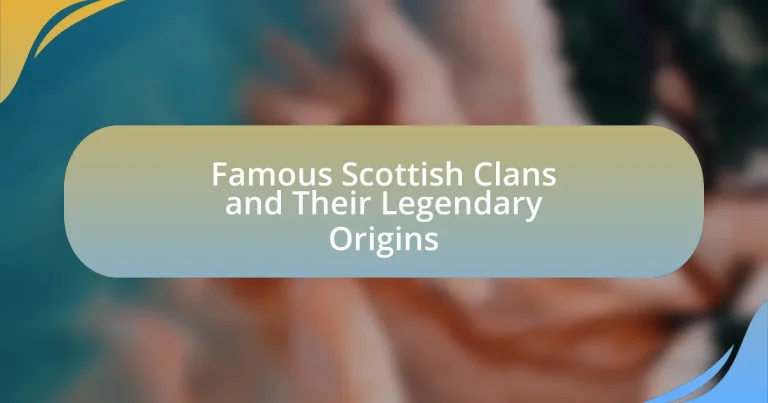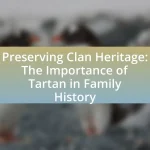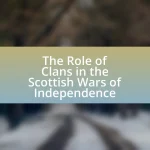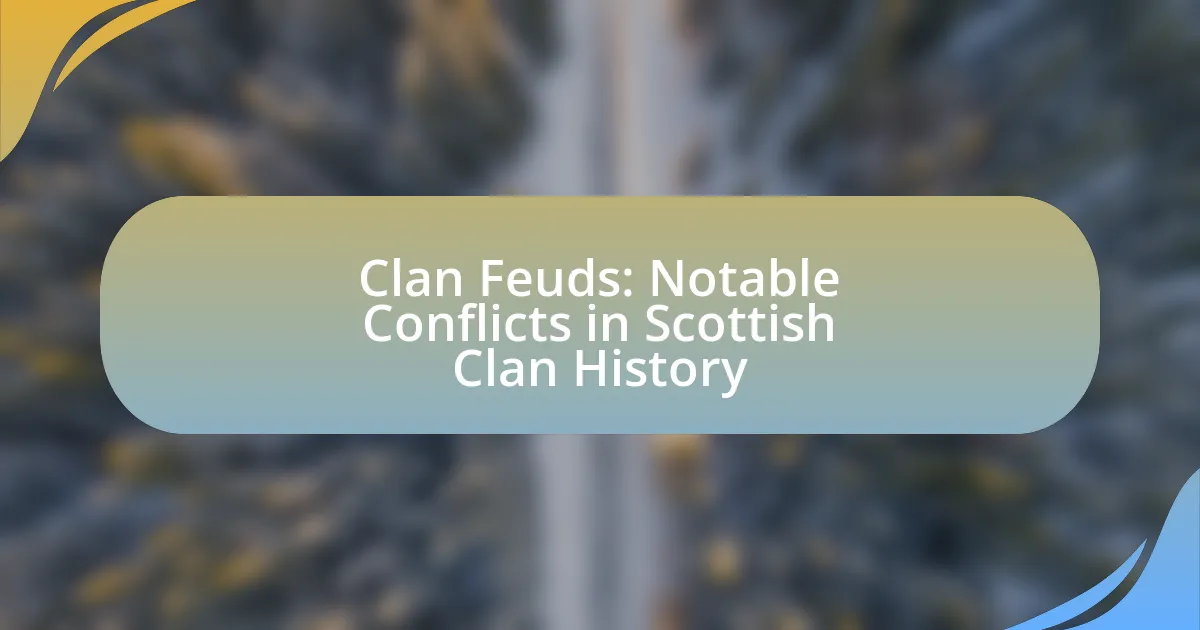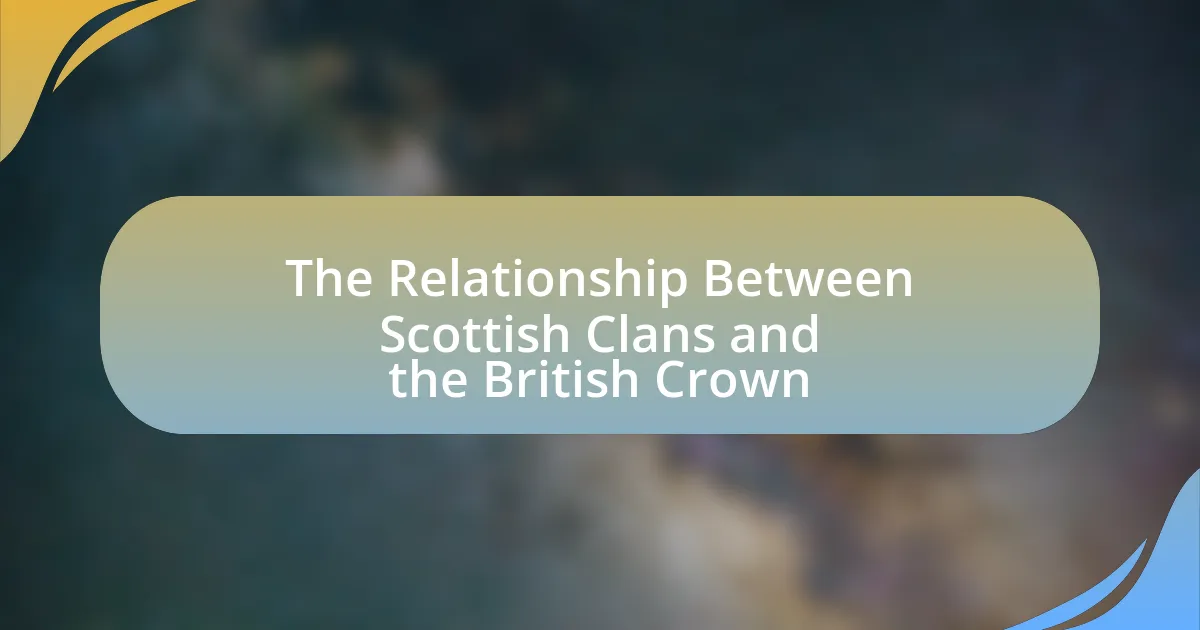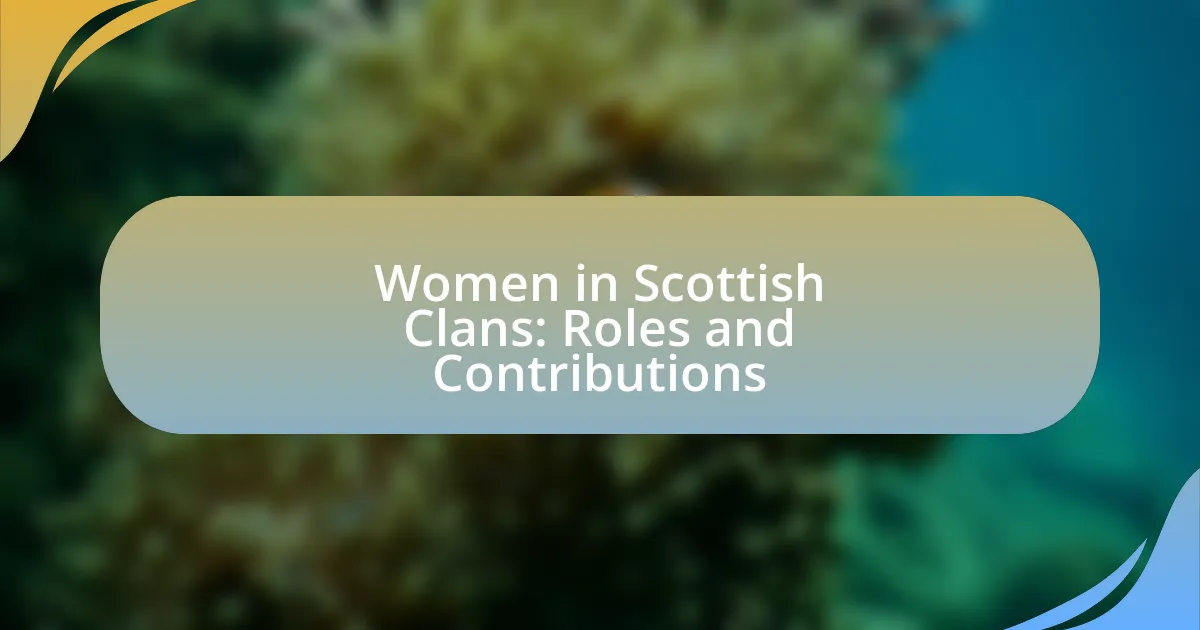The article focuses on famous Scottish clans, including the MacDonald, Campbell, and MacLeod clans, detailing their historical significance and legendary origins. It explores the formation of clans in early medieval Scotland, influenced by geography, historical events, and the feudal system, which shaped their social and political structures. The article also examines the cultural roles of clans, their contributions to Scottish identity, and the traditions associated with them, such as tartan patterns and clan gatherings. Additionally, it highlights the impact of clan rivalries on Scottish history and provides resources for exploring clan heritage and ancestry.

What are Famous Scottish Clans?
Famous Scottish clans include the MacDonald, Campbell, and MacLeod clans. The MacDonald clan, one of the largest and most powerful, traces its origins to the 12th century and played a significant role in Scottish history, particularly in the Highlands. The Campbell clan, known for its influence in Argyll, has a history dating back to the 13th century and was involved in various historical conflicts, including the Wars of Scottish Independence. The MacLeod clan, originating from the Isle of Skye, is renowned for its rich heritage and legendary figures, such as the 13th-century warrior Leod. These clans are integral to Scotland’s cultural identity and history, with each having unique stories and contributions to the nation’s past.
How did Scottish clans originate?
Scottish clans originated in the early medieval period as kinship groups that were formed around a common ancestor, often linked by blood or marriage. These clans emerged as a response to the need for social organization and protection in a landscape characterized by tribal warfare and territorial disputes. Historical records indicate that by the 12th century, clans were recognized as distinct entities, with leaders known as chiefs who held authority over their members and lands. The clan system was further solidified by the feudal system introduced by the Normans, which integrated clan loyalty into the broader social structure of Scotland.
What historical events contributed to the formation of clans?
The formation of clans in Scotland was significantly influenced by historical events such as the feudal system’s establishment in the 12th century, the Scottish Wars of Independence in the 13th and 14th centuries, and the socio-political landscape of the Highlands. The feudal system encouraged the organization of families into clans for mutual protection and land management, while the Wars of Independence fostered a sense of loyalty and identity among clans as they united against external threats, particularly from England. Additionally, the clan system was solidified through the need for social structure and governance in the often tumultuous Highland regions, where kinship ties became essential for survival and power dynamics.
How did geography influence clan development?
Geography significantly influenced clan development by determining resource availability, settlement patterns, and defense strategies. In Scotland, the rugged terrain and mountainous regions created natural barriers that led to the formation of distinct clans, each occupying specific territories. For instance, clans like the MacKenzies thrived in the Highlands, where the geography provided both protection and access to hunting grounds. Additionally, proximity to rivers and coastlines facilitated trade and communication, further shaping clan dynamics. Historical records indicate that clans often engaged in territorial disputes, influenced by the geographical boundaries that defined their lands, reinforcing the importance of geography in their social and political structures.
What roles do clans play in Scottish culture?
Clans play a central role in Scottish culture by serving as social units that foster identity, community, and heritage among their members. Each clan is associated with specific historical narratives, symbols, and tartans, which contribute to a sense of belonging and pride. For instance, the Clan Campbell and Clan MacDonald have distinct histories that reflect their influence in Scottish history, including battles and alliances. Clans also organize gatherings and events, such as Highland Games, which celebrate Scottish traditions and reinforce clan loyalty. Furthermore, clans often maintain connections to ancestral lands, which are significant in preserving cultural heritage and history.
How do clans contribute to Scottish identity?
Clans significantly contribute to Scottish identity by embodying a sense of community, heritage, and cultural continuity. Each clan represents a unique lineage, often tracing back to historical figures or events, which fosters a strong connection to Scotland’s past. For instance, the MacDonald clan, one of the largest in Scotland, has roots that date back to the 12th century, symbolizing loyalty and resilience. Clans also play a vital role in Scottish traditions, such as clan gatherings and Highland games, which celebrate shared customs and foster a collective identity among Scots. Furthermore, the use of tartans, specific to each clan, serves as a visual representation of this identity, reinforcing pride and belonging among members.
What traditions are associated with Scottish clans?
Scottish clans are associated with several traditions, including the use of tartan patterns, clan gatherings, and the practice of clan feuds. Tartan patterns, unique to each clan, symbolize identity and heritage, often worn during formal events and celebrations. Clan gatherings, known as clan rallies, serve as opportunities for members to connect, celebrate their lineage, and participate in traditional games. Additionally, clan feuds historically defined relationships between clans, often leading to conflicts over land and resources, which were a significant aspect of clan culture in Scotland. These traditions reflect the deep-rooted sense of community and identity within Scottish clans.
Why are clans significant in Scottish history?
Clans are significant in Scottish history because they served as the primary social and political units, shaping the identity and culture of Scotland. Historically, clans provided a sense of belonging and loyalty among members, often uniting families under a common name and leader, known as a chief. The clan system was crucial during the medieval period, particularly in the Highlands, where clans engaged in alliances, conflicts, and land disputes, influencing the political landscape. For example, the Clan Campbell and Clan MacDonald were involved in notable historical events such as the Wars of Scottish Independence and the Jacobite uprisings, which further solidified their importance in Scottish heritage.
What impact did clans have on Scottish politics?
Clans significantly influenced Scottish politics by serving as powerful social and political units that shaped alliances and conflicts. Historically, clans operated under a system of loyalty and kinship, which allowed them to wield considerable influence over local governance and military actions. For instance, during the Wars of Scottish Independence in the 13th and 14th centuries, clan leaders mobilized their followers to support figures like William Wallace and Robert the Bruce, thereby impacting the broader political landscape. Additionally, the clan system contributed to the feudal structure of Scotland, where clan chiefs held lands and power, directly affecting the political dynamics of the region. The Jacobite uprisings in the 18th century further exemplified the political impact of clans, as they rallied support for the Stuart claim to the throne, demonstrating their enduring role in shaping Scottish political history.
How did clan rivalries shape Scotland’s history?
Clan rivalries significantly shaped Scotland’s history by influencing political alliances, warfare, and social structures. The intense competition among clans, such as the MacDonalds and the Campbells, often led to violent conflicts that altered territorial control and power dynamics. For instance, the feud between the MacLeods and the MacDonalds in the 16th century exemplified how clan disputes could escalate into broader conflicts, impacting local governance and land ownership. Additionally, these rivalries contributed to the formation of Scottish identity, as clans rallied around their heritage and traditions, fostering a sense of loyalty and community. The outcome of clan battles, such as the Battle of Culloden in 1746, not only determined clan dominance but also marked significant shifts in Scottish governance and culture, leading to the eventual decline of the clan system and the rise of centralized authority.
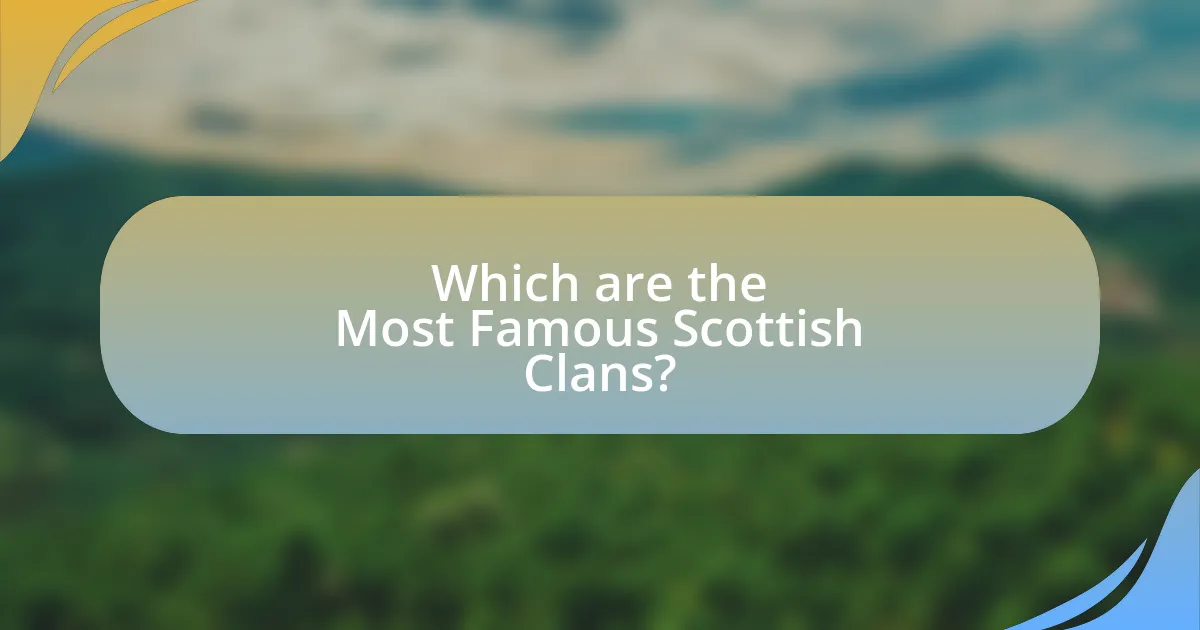
Which are the Most Famous Scottish Clans?
The most famous Scottish clans include the MacDonald, Campbell, MacLeod, and Stuart clans. The MacDonald clan, known as one of the largest and most powerful, has a rich history tied to the Hebrides and the Isle of Skye. The Campbell clan, historically influential in Scottish politics, played a significant role in the 17th century and is associated with the Argyll region. The MacLeod clan, with its roots in the Isle of Skye, is famous for its stronghold at Dunvegan Castle. The Stuart clan, which produced several Scottish kings, is renowned for its pivotal role in Scottish history, particularly during the Wars of Scottish Independence and the Jacobite uprisings.
What are the key characteristics of notable Scottish clans?
Notable Scottish clans are characterized by their distinct lineage, territorial claims, and unique tartans. Each clan typically traces its ancestry to a common ancestor, often a historical figure or warrior, which fosters a strong sense of identity and loyalty among its members. Territorial claims are significant, as clans often controlled specific regions in Scotland, leading to conflicts and alliances with other clans. Unique tartans serve as visual symbols of clan identity, with specific patterns and colors representing different clans, a tradition that dates back to the 16th century. These characteristics are foundational to the social structure and cultural heritage of Scotland, reflecting the clans’ historical significance in Scottish society.
What distinguishes the MacDonald clan from others?
The MacDonald clan is distinguished from others primarily by its historical significance as one of the largest and most powerful clans in Scotland, particularly during the Middle Ages. The clan’s prominence is rooted in its control over vast territories in the Highlands and its role in key historical events, such as the Wars of Scottish Independence. The MacDonalds were known for their fierce loyalty to the Scottish crown and their involvement in clan rivalries, notably with the Campbells. Their legacy includes the establishment of the Lordship of the Isles, which was a significant political entity in medieval Scotland, further solidifying their influence and status among Scottish clans.
How did the Campbell clan rise to prominence?
The Campbell clan rose to prominence through strategic marriages, political alliances, and military prowess. In the 14th century, they gained significant power by aligning with the Scottish crown, particularly under King Robert the Bruce, which allowed them to acquire vast lands in the Highlands. Their influence expanded further during the 15th and 16th centuries as they played crucial roles in various conflicts, including the Wars of the Roses and the Jacobite uprisings, solidifying their status as one of Scotland’s most powerful clans. The clan’s ability to navigate complex political landscapes and their involvement in key historical events contributed to their enduring prominence in Scottish history.
What legendary origins do famous clans claim?
Famous Scottish clans claim various legendary origins, often tracing their ancestry to mythological figures or historical heroes. For example, the Clan Campbell asserts descent from the ancient Gaelic king, Diarmaid, while the Clan MacDonald claims lineage from the legendary figure, Somerled, a 12th-century warlord. Additionally, the Clan MacLeod connects its roots to Leod, a figure believed to be a son of the Norse king, while the Clan Fraser claims descent from the historical figure, Sir Simon Fraser, who fought against the English in the Wars of Scottish Independence. These claims are often supported by historical texts and clan traditions that emphasize their noble heritage and connections to significant events in Scottish history.
What myths surround the origins of the MacLeod clan?
The MacLeod clan’s origins are surrounded by myths that suggest they descend from Leod, a 13th-century figure believed to be a son of the Norse king of Man. This narrative is supported by the clan’s own historical records, which trace their lineage back to Leod, who is said to have established the clan on the Isle of Skye. Additionally, some legends claim that the MacLeods are descended from the ancient Celtic kings of Scotland, further intertwining their identity with both Norse and Gaelic heritage. These myths reflect the clan’s rich cultural tapestry and the blending of different historical influences in their ancestry.
How does the history of the Bruce clan reflect its legendary status?
The history of the Bruce clan reflects its legendary status through its pivotal role in Scottish independence, particularly under Robert the Bruce, who became King of Scots in 1306. Robert’s leadership during the Wars of Scottish Independence, especially his victory at the Battle of Bannockburn in 1314, solidified the clan’s reputation as a symbol of resistance against English rule. This battle is often regarded as a turning point in the struggle for Scotland’s sovereignty, showcasing the clan’s military prowess and strategic acumen. Additionally, the clan’s lineage, tracing back to the 12th century, and its connection to significant historical events contribute to its enduring legacy in Scottish history.
What symbols and tartans represent famous clans?
Symbols and tartans representing famous Scottish clans include the thistle for Clan Campbell, the lion rampant for Clan Stewart, and the stag for Clan MacKintosh. Each clan’s tartan is unique; for example, the Campbell tartan features shades of green and blue, while the Stewart tartan is characterized by red and green stripes. These symbols and tartans serve as identifiers of clan heritage and pride, with historical significance tied to the clans’ origins and their roles in Scottish history.
How do clan crests and mottos reflect clan heritage?
Clan crests and mottos serve as visual and textual representations of clan heritage, encapsulating the values, history, and identity of the clan. Each crest typically features symbols that are significant to the clan’s lineage, such as animals, plants, or objects that reflect historical events or characteristics associated with the clan. For example, the crest of Clan MacDonald includes a ship, symbolizing their maritime heritage and historical connections to the sea. Mottos, often in Gaelic or Latin, convey the clan’s ethos or guiding principles, such as Clan Campbell’s motto “Ne Obliviscaris,” meaning “Do not forget,” which emphasizes loyalty and remembrance of their ancestry. Together, these elements not only distinguish clans from one another but also preserve and communicate their unique stories and traditions across generations.
What is the significance of tartan patterns in clan identity?
Tartan patterns are significant in clan identity as they serve as a visual representation of a clan’s heritage and lineage. Each tartan design is unique to a specific clan, symbolizing its history, values, and traditions. Historically, the use of tartan became prominent in the 18th century, particularly after the Jacobite risings, when clans adopted distinct patterns to foster unity and pride. The Scottish Tartan Act of 1782 further solidified this connection by allowing clans to officially register their tartans, reinforcing their identity and cultural significance.
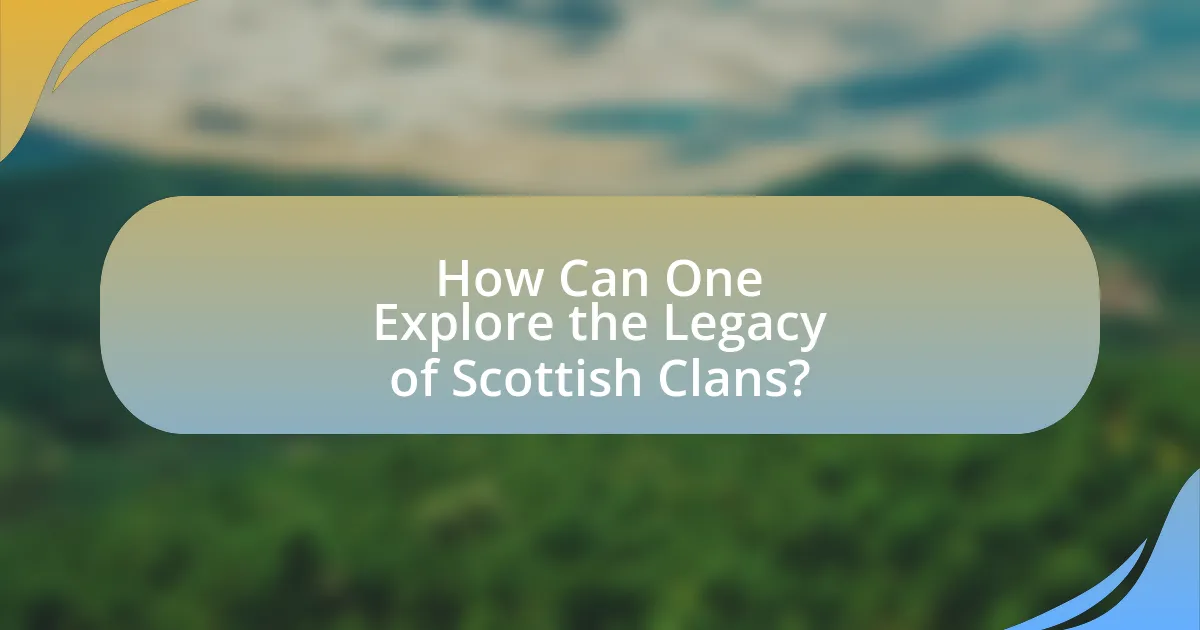
How Can One Explore the Legacy of Scottish Clans?
One can explore the legacy of Scottish clans by researching historical records, visiting clan museums, and participating in clan gatherings or events. Historical records, such as the “Scots Peerage” and “The Clan and Family Encyclopedia,” provide detailed accounts of clan histories and genealogies. Clan museums, like the Clan Campbell Museum and the Clan MacGregor Museum, offer artifacts and exhibitions that illustrate the cultural significance of clans. Additionally, attending events like the Scottish Highland Games allows individuals to engage with clan representatives and learn about their traditions and heritage.
What resources are available for learning about Scottish clans?
Books, websites, and historical societies are key resources for learning about Scottish clans. Notable books include “The Clans of Scotland” by John Parker, which provides detailed histories and genealogies of various clans. Websites such as the Clan Campbell Society and the Scottish Clan and Family Encyclopedia offer extensive information on clan origins, tartans, and family connections. Additionally, organizations like the Scottish Genealogy Society provide access to records and expert guidance for those researching their clan heritage. These resources collectively offer a comprehensive understanding of Scottish clans and their historical significance.
How can historical records enhance understanding of clan histories?
Historical records enhance understanding of clan histories by providing documented evidence of lineage, events, and cultural practices. These records, such as birth and marriage certificates, land grants, and clan charters, offer insights into the social structure and historical significance of clans. For example, the Clan Campbell’s historical records detail their rise to power in the 15th century, illustrating their influence in Scottish politics and society. Additionally, records from the Scottish Parliament and local archives reveal alliances and conflicts between clans, enriching the narrative of clan interactions and their impact on Scottish history.
What role do clan societies play in preserving clan heritage?
Clan societies play a crucial role in preserving clan heritage by acting as custodians of traditions, history, and cultural practices specific to each clan. These societies organize events, such as clan gatherings and festivals, which reinforce a sense of identity and belonging among members. Additionally, they maintain records of lineage and genealogy, ensuring that the stories and achievements of ancestors are passed down through generations. For instance, the Clan Campbell Society actively promotes the history and culture of the Campbells, providing resources and support for members to connect with their heritage. This structured approach to heritage preservation helps maintain the unique characteristics and narratives of each clan, fostering a continuous link to the past.
What are some tips for engaging with Scottish clan culture?
To engage with Scottish clan culture, participate in clan gatherings and events, which often include traditional music, dance, and storytelling. These events, such as Highland Games and clan festivals, provide immersive experiences that celebrate heritage and foster community connections. Additionally, researching your own clan’s history and tartan can deepen your understanding and appreciation of the culture. Engaging with local historians or clan societies can also offer insights into customs and traditions, enhancing your connection to Scottish clan culture.
How can one participate in clan gatherings or events?
To participate in clan gatherings or events, individuals should first identify the specific clan they wish to engage with and then check the clan’s official website or social media pages for announcements regarding upcoming events. Many clans organize annual gatherings, festivals, or local meetings that are open to members and the public. Participation often requires registration or membership in the clan, which can typically be completed online. For example, the Clan Campbell Society hosts events that are accessible to both members and non-members, providing opportunities for cultural engagement and networking.
What are the best practices for researching one’s clan ancestry?
The best practices for researching one’s clan ancestry include starting with personal records, utilizing online genealogy databases, and consulting historical documents. Personal records such as birth certificates, marriage licenses, and family trees provide foundational information. Online databases like Ancestry.com and FamilySearch.org offer extensive resources, including census data and immigration records, which can help trace lineage. Additionally, historical documents such as clan histories, local archives, and church records can provide context and verify connections. Engaging with local historical societies or clan organizations can also yield valuable insights and resources specific to Scottish clans.
